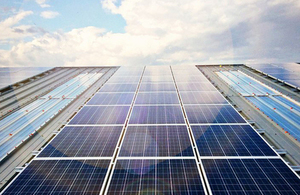Green initiatives from Britain鈥檚 abandoned coal mines
As part of Green GB Week, the Coal Authority has highlighted its award-winning approach to delivering sustainable solutions from Britain鈥檚 coal mining legacy.

Solar panels at one of the Coal Authority's mine water treatment scheme
The Coal Authority outlined how this legacy is now playing its part in the drive for green energy, clean growth and sustainability.
A number of initiatives are now helping to save costs, generate income and support sustainable energy as part of the government鈥檚 Clean Growth Strategy.
Lisa Pinney MBE, Chief Executive, Coal Authority, said:
We鈥檙e delighted to support Green GB Week and committed to working with the Department for Business, Energy and Industrial Strategy to promote the government鈥檚 Clean Growth Strategy and Heat Networks Investment Project.
We鈥檙e committed to changing our mind set from one focused on dealing with the problems of Britain鈥檚 mining legacy to one that focuses on the opportunities of our mining heritage.
To fully realise these opportunities we鈥檙e thinking differently, working with others and being bold in our approach.
Low carbon energy and water supply resilience
Work is already underway to make the most of these opportunities for the nation. In a surprising role reversal, abandoned coal mines are now being considered as a potential new low carbon heat source.
Exciting developments such as ground based solar installations and power efficiencies on former colliery sites are also saving the Coal Authority 拢0.7 million this year alone.
Water from mine water treatment schemes, and water stored in abandoned mines, could play an important role in balancing water supplies for consumption or the environment in future: mines themselves could play a role in storing water during flood conditions.
Innovations in mine water treatment
New uses for by-products from coal mine water treatment are also among the 鈥榞reen鈥� innovations developed by the Coal Authority.
Ochre used to be classed as waste but has been developed as a pigment for the fine arts market. It can also be used to remediate contaminated land.
Iron removed from mine water during the treatment process is also being used to remove phosphorus as part of the sewage treatment process. This helps to improve water quality and support river ecology.
Claire Perry, Minister for Energy and Clean Growth, said:
The UK has led the world in cutting emissions whilst growing our economy - with clean growth driving incredible innovation and creating hundreds of thousands of high quality jobs.
Ten years on from the Climate Change Act, the first ever Green GB week is a time to build on our successes and explain the huge opportunities for business and young people of a cleaner economy.
I鈥檓 delighted to see how many more businesses and organisations such as the Coal Authority are seizing this multi-billion pound opportunity to energize their communities to tackle the very serious threat of climate change.
Discover more
Coal mines may no longer be the feature of Britain鈥檚 landscape that they once were, but their legacy is now revealing new opportunities for our generation to explore.
The Coal Authority will publish its latest Sustainability Report soon, which highlights its sustainability performance in 2017-18, during which time it:
- recycled over 3,700 tonnes of reedbed waste, reducing the environment impacts associated with landfill
- increased its portfolio of solar arrays, taking its renewable generating capacity to 712 kW
- reduced its carbon footprint, as part of its efficiencies programme
- won a prestigious edie Sustainability Leaders Award 2018, for its work in finding new ways to reuse waste products, and was shortlisted for Sustainable Business of the year